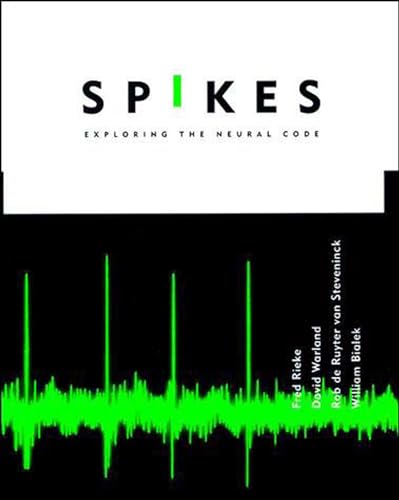Items related to Spikes: Exploring the Neural Code (Computational Neuroscienc...

Synopsis
What does it mean to say that a certain set of spikes is the right answer to a computational problem? In what sense does a spike train convey information about the sensory world? Spikes begins by providing precise formulations of these and related questions about the representation of sensory signals in neural spike trains. The answers to these questions are then pursued in experiments on sensory neurons. Intended for neurobiologists with an interest in mathematical analysis of neural data as well as the growing number of physicists and mathematicians interested in information processing by "real" nervous systems, Spikes provides a self-contained review of relevant concepts in information theory and statistical decision theory.
Our perception of the world is driven by input from the sensory nerves. This input arrives encoded as sequences of identical spikes. Much of neural computation involves processing these spike trains. What does it mean to say that a certain set of spikes is the right answer to a computational problem? In what sense does a spike train convey information about the sensory world? Spikes begins by providing precise formulations of these and related questions about the representation of sensory signals in neural spike trains. The answers to these questions are then pursued in experiments on sensory neurons.The authors invite the reader to play the role of a hypothetical observer inside the brain who makes decisions based on the incoming spike trains. Rather than asking how a neuron responds to a given stimulus, the authors ask how the brain could make inferences about an unknown stimulus from a given neural response. The flavor of some problems faced by the organism is captured by analyzing the way in which the observer can make a running reconstruction of the sensory stimulus as it evolves in time. These ideas are illustrated by examples from experiments on several biological systems.
Intended for neurobiologists with an interest in mathematical analysis of neural data as well as the growing number of physicists and mathematicians interested in information processing by "real" nervous systems, Spikes provides a self-contained review of relevant concepts in information theory and statistical decision theory. A quantitative framework is used to pose precise questions about the structure of the neural code. These questions in turn influence both the design and analysis of experiments on sensory neurons.
"synopsis" may belong to another edition of this title.
About the Author
Fred Rieke is Assistant Professor in the Department of Physiology and Biophysics, University of Washington. David Warland is Research Associate in the Department of Molecular and Cellular Biology, Harvard University. Rob de Ruyter van Steveninck is Research Scientist, William Bialek a Senior Research Scientist, both at the NEC Research Institute.
"About this title" may belong to another edition of this title.
FREE shipping within U.S.A.
Destination, rates & speedsSearch results for Spikes: Exploring the Neural Code (Computational Neuroscienc...
Spikes: Exploring the Neural Code
Seller: ThriftBooks-Dallas, Dallas, TX, U.S.A.
Paperback. Condition: Good. No Jacket. Pages can have notes/highlighting. Spine may show signs of wear. ~ ThriftBooks: Read More, Spend Less 1.48. Seller Inventory # G0262681080I3N00
Quantity: 1 available
Spikes: Exploring the Neural Code
Seller: ThriftBooks-Atlanta, AUSTELL, GA, U.S.A.
Paperback. Condition: Good. No Jacket. Pages can have notes/highlighting. Spine may show signs of wear. ~ ThriftBooks: Read More, Spend Less 1.48. Seller Inventory # G0262681080I3N00
Quantity: 1 available
Spikes: Exploring the Neural Code (Computational Neuroscience)
Seller: Bay State Book Company, North Smithfield, RI, U.S.A.
Condition: good. The book is in good condition with all pages and cover intact, including the dust jacket if originally issued. The spine may show light wear. Pages may contain some notes or highlighting, and there might be a "From the library of" label. Boxed set packaging, shrink wrap, or included media like CDs may be missing. Seller Inventory # BSM.OIWW
Quantity: 1 available
Spikes: Exploring the Neural Code
Seller: Anybook.com, Lincoln, United Kingdom
Condition: Good. This is an ex-library book and may have the usual library/used-book markings inside.This book has soft covers. In good all round condition. Please note the Image in this listing is a stock photo and may not match the covers of the actual item,750grams, ISBN:9780262681087. Seller Inventory # 5953926
Quantity: 1 available
Spikes: Exploring the Neural Code (Computational Neuroscience) (A Bradford Book)
Seller: Anybook.com, Lincoln, United Kingdom
Condition: Fair. This is an ex-library book and may have the usual library/used-book markings inside.This book has soft covers. In fair condition, suitable as a study copy. Please note the Image in this listing is a stock photo and may not match the covers of the actual item,750grams, ISBN:9780262681087. Seller Inventory # 9798770
Quantity: 1 available
Spikes : Exploring the Neural Code
Seller: Buchpark, Trebbin, Germany
Condition: Sehr gut. Zustand: Sehr gut | Seiten: 414 | Sprache: Englisch | Produktart: Bücher. Seller Inventory # 1504939/202
Quantity: 1 available
SPIKES
Seller: OM Books, Sevilla, SE, Spain
Condition: Usado - bueno. Seller Inventory # 9780262681087
Quantity: 1 available
Spikes: Exploring the Neural Code (Computational Neuroscience)
Seller: Toscana Books, AUSTIN, TX, U.S.A.
Paperback. Condition: new. Excellent Condition.Excels in customer satisfaction, prompt replies, and quality checks. Seller Inventory # Scanned0262681080
Quantity: 1 available

